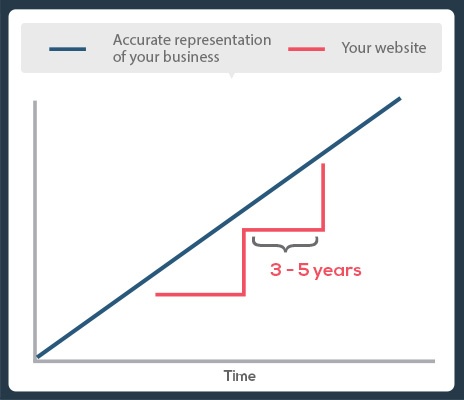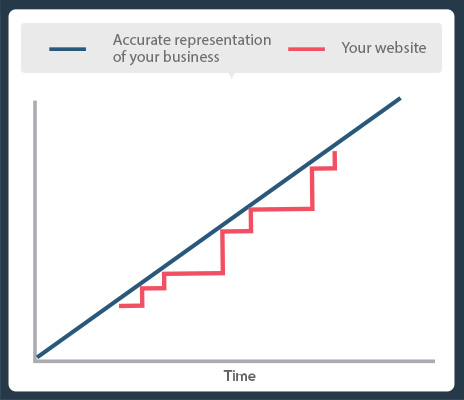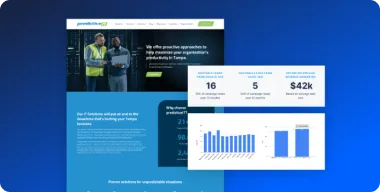No, your website is not done, and it never will be. Your website is the primary face of your company. It’s where people make their initial impressions of what kind of business you are and the quality of work you provide.
You wouldn’t say that your business is a static entity; it adjusts to the needs and desires of the market, your customers, your employees and yourself. So why would you let your website be a static entity that sits unchanged for years at a time? It needs to consistently evolve to reflect the ever changing face of your business.
Learning from the past
Before taking on a new client, we always review the design, content, optimization and structure of their existing site. To be a little blunt, some of them – actually, a lot of them – are atrocious. They look like they were created on GeoCities in 1998. They’re cumbersome to navigate and don’t have a clear goal to point visitors toward. And perhaps most importantly, they no longer accurately represent the business behind them.
The problem these companies face stems from a business decision they made a few years ago. They chose to pay a designer several thousand dollars to build them a website. That designer handed over all the files and said, “Ok, your website is done!” Everyone rejoiced at the new site, but the celebrations didn’t last long because as soon as the business evolved, updating the site along with it became a huge hassle.
Spending several thousand dollars on a website is a serious investment for a small business and it’s understandable that business owners want to see a return on that investment before splurging on another new site. The problem is that a lot of business owners wait until their website is embarrassingly out of date before redesigning it.
Their long-term design plan looks something like this:

This method of doing massive redesigns every 3-5 years isn’t sustainable. Sure, a lot of companies can afford to drop $5,000-10,000 every few years, but the return on your initial invest continually decreases as your website become more and more out of date. Overall, you end up getting less value from this method than you might think because you actually spend very little time at the top of the current web standards and very little time accurately representing your business.
A website is like a car – as soon as you drive off the lot, its value greatly decreases, and soon enough, it’s getting passed by newer, sleeker models.
Planning for the future
Steve Blank famously said that “No plan survives first contact with customers.” In a way, the same applies to websites. The truth is that no matter how much experience a web designer or copywriter has, they can’t definitively say how their work will perform once it’s placed in front of your clients and they certainly can’t plan for changes in your business down the road.
Making agility a key component of managing your website will keep it constantly evolving and growing. Quicker iterations and more frequent updates will not only keep you closer to the top standards across the web, but they will also ensure that your business is always accurately represented and will allow you to make adjustments based on how visitors interact with your site.
Under this agile model, your design plan looks more like this:

Rather than basing your decision to update your design on the need to rid yourself of an embarrassing website, changes and updates are made as necessary based on changes in your business or the market.
Managing your website under this sort of model isn’t really possible with a traditional web designer. Typically, designers don’t stick around to continually make tweaks and adjustments after completing your contracted project.
What you really need is a Website-as-a-Service type of contract that allows you to work with a dedicated team who is always on call to make changes to your Internet Presence – kind of like, well, us.
Real world examples
We get hundreds of requests from our clients everyday. They range from simple questions to requests for major site overhauls and our team is ready to jump on all of them. I wanted to share a few examples here of how using an agile website management model, like Pronto, can be really effective.
A change in direction
One of our clients recently came to us explaining that he was expanding his business to include Apple support services. And more importantly, he was going to be the only Apple business support center in his local market, so this had the potential to become a huge part of his business.
He, of course, wanted to make this new service really stand out on his website, so we quickly got to work. Within a couple of days, we had a new page on his site describing the service in detail along with a new banner and widget on his homepage promoting the service.

Without the assistance of a Website-as-a-Service agency, something like this could potentially require working with three different vendors: a writer to draft the copy, a designer to put together the Photoshop files, and depending on your technical skills, a developer to implement everything.
Small website updates like this are necessary all the time, and as a business owner, you don’t want to waste your time trying to coordinate so many people. In our client’s case, all he had to do was make the initial request and then approve the final content and designs. We took care of everything else.
A whole new business
More often than you would think, we get requests for major site overhauls. The reasons behind these requests run the gamut from a logo design change that needs to be reflected across the entire site to a merger with another business to a fundamental change in the strategy of the business.
When your business comes to a crossroads like this, it’s important that you work with someone who understand both your business and the change you are going through. Sure, your designer from a few years ago probably remembers you, but does he know about the changes your company has gone through since then?
Working with an agile web design company makes sure that you build a long lasting relationship which helps these big transitions go more smoothly.
Conclusion
Visitors that arrive at your site make immediate, snap judgements about what type of business you are. If your current website doesn’t accurately portray your company, you run the risk of those visitors leaving for a competitor who has a sleeker, up-to-date, more accurate website. Go agile and stay on top of your competitors.




